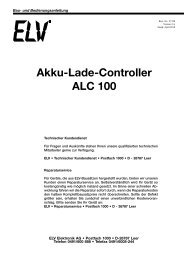Akku-Lade-Center Battery Charging Centre ALC 8500-2 ... - Batimex
Akku-Lade-Center Battery Charging Centre ALC 8500-2 ... - Batimex
Akku-Lade-Center Battery Charging Centre ALC 8500-2 ... - Batimex
Erfolgreiche ePaper selbst erstellen
Machen Sie aus Ihren PDF Publikationen ein blätterbares Flipbook mit unserer einzigartigen Google optimierten e-Paper Software.
After you have selected the processing function you wish to use, all the essential parameters for<br />
processing the battery pack are concluded, and are displayed on the screen when you confirm your<br />
selection by pressing the “OK / Menu” button briefly. Now press the “OK / Menu” button again to<br />
initiate the process. The program returns to the main menu; confirm once more with “Return”, and the<br />
screen displays the main window again.<br />
During the process the top half of the screen shows the voltage, current and battery capacity which<br />
can be read off directly; the measured values are constantly updated while the processing progresses.<br />
The screen also shows all the important status information for the corresponding charge channel. If<br />
you wish to halt the program at any time for any reason, simply select the channel in the “Chan-Menu”<br />
and select “Stop”.<br />
13. B. Resist. (Ri measurement function)<br />
Selecting the sub-menu “B. Resist.” from the main menu takes you<br />
to the <strong>ALC</strong> <strong>8500</strong>-2 Expert’s internal battery resistance measurement<br />
function (Fig. 21). Press the “OK / Menu” button briefly to move to the<br />
display window shown in Fig. 22.<br />
In principle the method of measuring internal resistance is extremely<br />
simple: the battery is discharged at a high, carefully defined current,<br />
and the voltage decline compared to the unloaded state is measured.<br />
The internal resistance can now be calculated by dividing the voltage<br />
difference by the load current.<br />
As we are dealing with very small resistances here, the load current<br />
on the battery needs to be as high as possible. However, a continuous<br />
high current would generate a great deal of waste heat, and would<br />
also discharge the battery to a significant extent. These problems can<br />
be avoided by using pulses of current to measure the internal resistance.<br />
The current pulses with the <strong>ALC</strong> <strong>8500</strong>-2 Expert are variable within the<br />
range 1 A to 10 A, although we recommend selecting as high a current<br />
as possible, otherwise - bearing in mind the typically low internal resistance<br />
of these batteries - the voltage drop will be extremely small.<br />
Low current pulses only make sense with batteries which are unable<br />
to cope with high peak loads.<br />
Informative results can only be achieved if the voltage is measured<br />
directly at the battery terminals, otherwise voltage fall-off in the<br />
Fig. 21: <strong>Battery</strong> Ri measurement<br />
function<br />
Fig. 22: Setting the pulsed<br />
current for battery Ri measurement<br />
measurement cables would seriously falsify the result. To fulfil these requirements, special measurement<br />
cables are used, each wire featuring two spring-loaded probes (see Fig. 1). These probes make reliable<br />
contact with the terminal caps of the battery (or other desired measurement points). The pulse<br />
of discharge current flows through the broad contacts of the measurement cables, and the second<br />
contact is used to record the measurement directly at the terminal caps of the battery.<br />
If you wish to include the losses caused by cables and connectors in the resistance measurement,<br />
then simply position the probes at the appropriate points. The spring-loaded probes ensure reliable<br />
electrical contact at all four measurement points.<br />
Important: when carrying out the measurement the spring contacts must always be pushed hard<br />
against the contact surfaces of the battery, i.e. as far as they will go. When carrying out comparative<br />
measurements at different cells it is essential to use identical contact surfaces. Even welded solder<br />
tags have a considerable influence on the measured result. Typical values for individual very good<br />
sub-C cells are in the range 4 mOhm to 6 mOhm.<br />
The battery’s internal resistance is responsible for voltage losses in any battery-operated system, but<br />
it is not the only culprit: parasitic transfer resistance, caused by cables and connectors, can have a<br />
considerable influence. In any high-current applications all connectors should exhibit a large contact<br />
area and be a firm, secure fit.<br />
49



